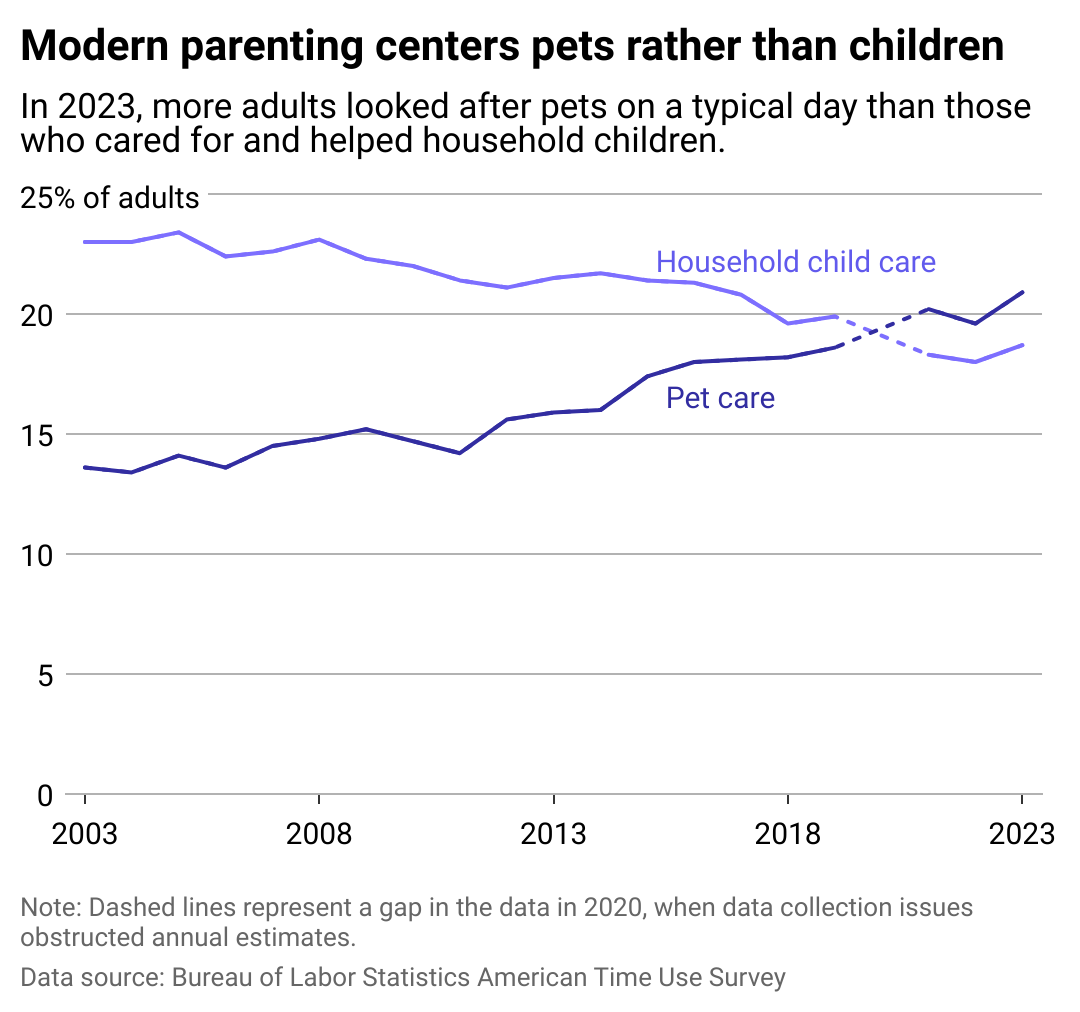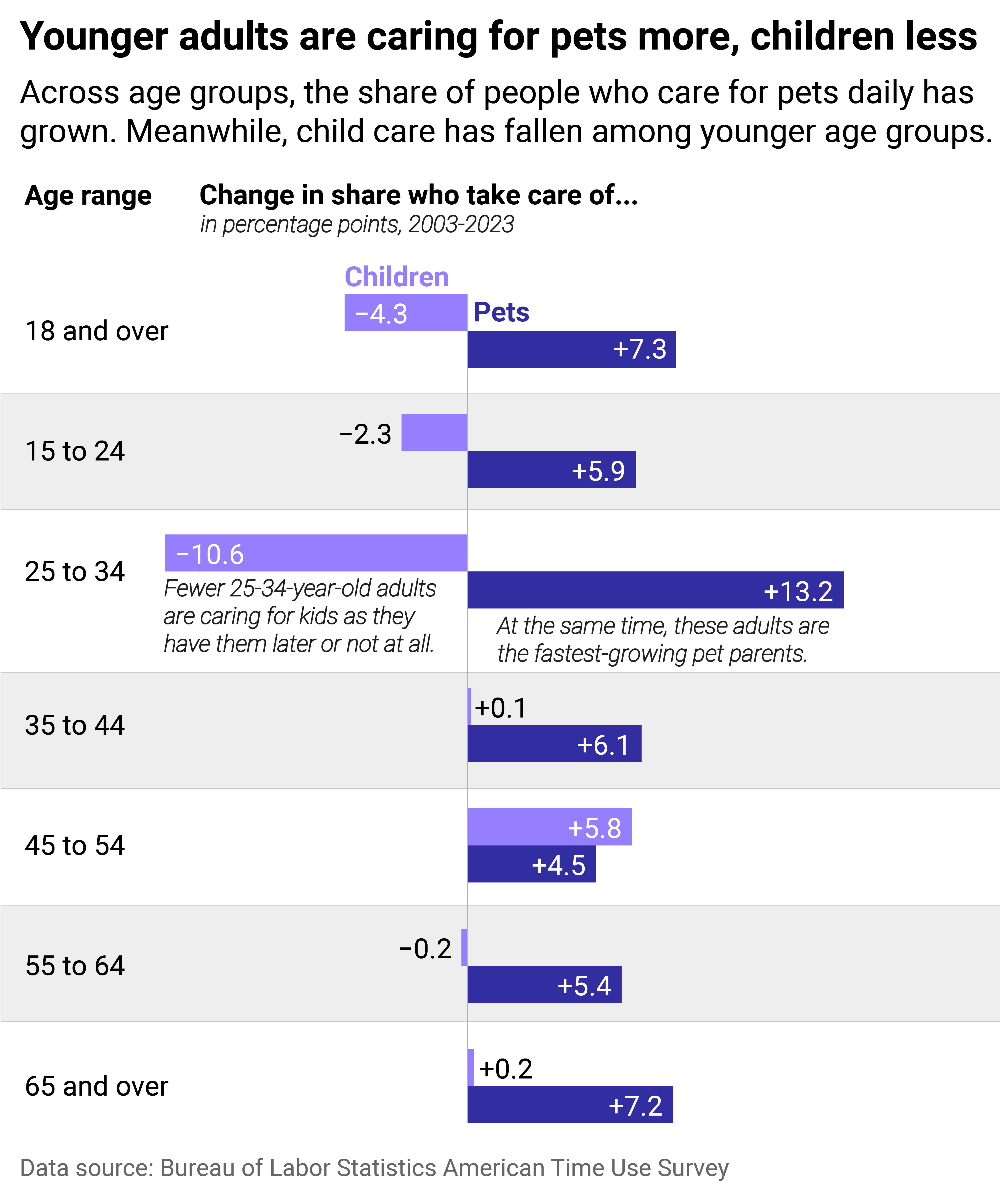More dogs, fewer babies: What's guiding the shifts in pet ownership and parenting in American households?

Canva
More dogs, fewer babies: What’s guiding the shifts in pet ownership and parenting in American households?
Four small dogs in a stroller.
Amid shrinking households and declining birth rates, one family member is increasingly taking center stage: the pet. In fact, half of Americans consider their pets to be as much a part of their family as human members, according to research from the Pew Research Center. Alongside their elevated status, pets are enjoying elevated living: American Pet Products Association data shows the American pet industry has surged from $90.5 billion in 2018 to an estimated $150.6 billion in 2024.
Part of this growth is attributable to the overall increase in pets. The American Society for the Prevention of Cruelty to Animals found that approximately 23 million households adopted a cat or dog during the COVID-19 pandemic, partly due to the shift to work from home that enabled many remote workers to trade commute time for puppy playtime. Plus, thanks to advances in pet nutrition and veterinary science, both cats and dogs are living longer on average.
Pew found that roughly 3 in 4 (74%) Americans are on board with this increasing focus on pets in daily life. Additionally, nearly half (48%) of adults say there is a proper amount of emphasis on pets’ well-being. In comparison, 1 in 4 (26%) believe there could be more, though just as many said there was too much. Interestingly, the generation most likely to consider their pets as equal members of the family, counterintuitively, also spends the least money on them.
To explore this dynamic and others, Ollie used Bureau of Labor Statistics time use data and news reports to analyze the evolving dynamic between parenting children and owning pets in the U.S., particularly among younger adults.
![]()

Ollie
Since 2021, more adults have been taking care of pets than children
A multiline chart showing the share of adults (over age 18) who provided care for pets and animals versus household children on an average day. The share caring for pets surpassed the share caring for children starting in 2021.
For those who may have avoided pet ownership due to scheduling or cost hesitations, the COVID-19-induced shift to remote work allowed them to reconsider their capacity for pet care. In fact, 2021 was the first year in at least the last two decades that more adults looked after pets than children—the same year that 1 in 5 American households adopted a pet. As of 2024, there are now 82 million households with at least one pet, according to the APPA national pet owners survey.
Now, there are more multipet owners than single-pet owners in America. Pew found that 35% of American households have multiple pets, and 27% have one pet, totaling 62% of Americans who share their home with another species.
Adding to the disparity in households without children is the increasing number of baby boomer-led households. Their children are most likely living independently from their parents. While pets have shorter life spans than humans, they remain consistently dependent on caretakers throughout their lives—unlike children, who generally develop independence and require fewer hours of direct caretaking as they age.

Ollie
Younger adults shifting care from kids to pets
A grouped bar chart showing the change over time in share of adults who cared for children versus pets on an average day. Change is shown as percentage points and measures the difference from 2003 to 2023.
The fastest-growing generation of pet parents are those aged 25 to 34, which include millennials and Gen Zers. This age group, though, still has more households caring for kids (30.8%) than households watching over pets (22.9%), though the gap has narrowed in the last two decades. For those aged 45 to 54, the ratio evens out: They are as likely to take care of children as they are to care for pets. At 55, the odds shift the other way: By then, this age group is more likely to care for pets, coinciding with the transition into retirement.
In the U.S., 4 in 5 (82%) millennials are also most likely to view their pets as children, according to May 2024 data from the Statista Research Department. Still, they spend the least on their pets based on BLS data. (The dataset did not compare Gen Z figures due to a reporting error.)
This counterintuitive relationship may reveal some insights about the decline in households with children. Because wage growth has not kept pace with increasing housing costs, based on BLS and Federal Housing Finance Agency data, many adults must now prioritize developing their careers for years before they can afford to establish and care for families. According to a study by the Harvard Joint Center for Housing Studies, the home price-to-income ratio reached an all-time high in many metros in 2022, the latest year measured. Additionally, the percentage of young workers with employers who provide health insurance has plummeted since 1989, further challenging those in need of maternal care or health insurance for their children.
While it is true that birth rates for millennials and Gen Zers taken together have declined, this is still subject to change. As of 2024, about 1 in 5 Americans are choosing to have their first child after age 35, and the average age of first-time mothers is at a record high of 27.5 and climbing, according to 2021 data from the CDC, the latest available. But no matter how family structures and dynamics continue to evolve, pets appear to be along for the ride for the foreseeable future. As animal shelter populations continue to increase, hopefully the households welcoming multiple species will too.
Story editing by Carren Jao. Additional editing by Kelly Glass. Copy editing by Paris Close. Photo selection by Lacy Kerrick.
This story originally appeared on Ollie and was produced and
distributed in partnership with Stacker Studio.